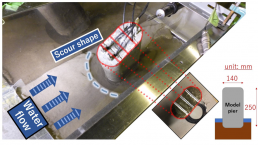Seeing the scouring phenomenon from the geotechnical perspective/ 洗掘という現象を地盤工学的にとらえる
Partial scour around the basement of the bridge pier is one of the critical incidents that is caused by a flood. Although some empirical design procedures and countermeasures are established, they are not fully composed systematically. As of now, the scouring phenomenon is approached from a hydraulic view which focuses on the intensity of flow (action). The objective of the study is to grasp the dynamic scouring by analyzing the subsoil condition such as density, grain distribution.
出水により河川橋脚が受ける被害の1つに、橋脚基礎地盤の洗掘に伴う上部工の変状が挙げられる。建設年代が古く河積阻害率の大きい鉄道橋梁を中心にみられるこの被害形態に対して、暫定の設計指針や対策工はある程度確立しているものの、体系的に整理されているとはいえない。従来、洗掘現象は作用としての流水に着目してアプローチがなされてきたが、本研究では浸食を受ける対象としての基礎地盤の河床材料(密度・粒度分布)に着目し、動的に進行する洗掘現象を多角的にとらえることを目標とする。
Model test / 模型実験
Experiments using the model pier are performed on two scales.
…[Small tank] Width: 0.3m, Length: 2m
Poorly graded gravel, silica sand #7, and a mixture of them are chosen as a subsoil. The relative density of the subsoil is uniformed in any cases. Varying the material type, the effect of the subsoil is analyzed by comparing the change of reaction forces on the bottom of the pier, top displacement, required time to collapse.
…[Large tank] Width: 1.2m, Length: 30m
Only poorly graded silica sand #4 is chosen as a subsoil. The shape of the pier, the angle which the pier faces against the flow, and with or without countermeasures are different in each case. In this large tank experiment, we mainly pay attention to the variables that govern the dynamic procedure of the scouring phenomena, like water level or flow velocity.
幅0.3m・長さ2mの小型水路と幅1.2m・長さ30mの大型水路を用いて、2つの環境で模型実験を行っている。
―小型水路
河床模型の材料として、粒度分布の悪い礫材・珪砂7号及びそれらを一定の割合で混合したものを用いている。河床模型の相対密度は材料にかかわらず統一している。根入れ深さ・河床材料の異なるケース間において流量が増加し洗掘が進行する過程で、橋脚の変位・地盤反力分布・変状が生じるまでの時間をそれぞれ比較し、河床材料が洗掘現象に与える影響を分析する。
―大型水路
河床模型の材料は珪砂4号で統一し、橋脚の形状・流水に対する角度・対策工の有無を変化させて実験を行い、動的な洗掘現象に支配的な因子が何かを定性的にとらえる。

